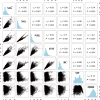The effects of PM2.5 components on the cardiovascular disease admissions in Shanghai City, China: a multi- region study
- PMID: 39741307
- PMCID: PMC11686859
- DOI: 10.1186/s12889-024-21179-0
The effects of PM2.5 components on the cardiovascular disease admissions in Shanghai City, China: a multi- region study
Abstract
Background: The burden of cardiovascular disease (CVD) is severe worldwide. Although many studies have investigated the association of particulate pollution with CVD, the effect of finer particulate pollution components on CVD remains unclear. This study aimed to explore the effect of five PM2.5 components ([Formula: see text], sulfate; [Formula: see text], nitrate; [Formula: see text], ammonium; OM, organic matter; BC, carbon black) on CVD admission in Shanghai City, identify the susceptible population, and provide clues for the prevention and control of particulate pollution.
Methods: Daily PM2.5 components data during 2013-2019 in three districts of Shanghai were obtained from Tracking Air Pollution in China. We obtained CVD daily admissions data from relevant departments of Tongji Hospital, including basic information (sex, age, time of admissions, ICD code of root cause of admissions, etc.). First, generalized additive model (GAM) and distributed lag non-linear (DLNM) model were used to evaluate the individual effects of PM2.5 components on CVD admission in three districts of Shanghai. Then, the three regions were pooled for analysis using either a random-effects model or a fixed-effects model.
Results: Overall, all five PM2.5 components had significant effects on CVD admission risk. BC and OM were strongly associated with daily CVD admissions, with increasing interquartile range of the concentrations, the maximum values of cumulative RR (95% CI) were 1.318 (95%CI: 1.222-1.415) and 1.243 (95%CI: 1.164-1.322), respectively. The elderly (≥ 65 years old) was more sensitive to the four PM2.5 components than the young population. [Formula: see text] and BC were strongest associated with CVD admissions in the elderly than in younger people, with increasing interquartile range of the concentrations, the maximum cumulative RR (95% CI) was 1.567 (95% CI: 1.116-2.019) and 1.534 (95% CI: 1.104-1.963), respectively.
Conclusions: This study found that five PM2.5 components were significant risk factors for CVD admissions and specific CVD diseases in Shanghai City. The elderly were susceptible to [Formula: see text],[Formula: see text], OM, and BC.
Keywords: Cardiovascular disease; China; Multi- region study; PM2.5 components.
© 2024. The Author(s).
Conflict of interest statement
Declarations. Ethics approval and consent to participate: The database of PM2.5 components is open. The data of CVD admissions used in this study are from the Tongji Hospital of Tongji University, who granted the permission. This research was approved by the Ethics Committee of the Tongji Hospital of Tongji University (Approval number: K-W-2024-011). The need for written informed consent was waived by the Ethics Committee of the Tongji Hospital of Tongji University due to retrospective nature of the study. All data used in this study were anonymized before its use. Consent for publication: Not applicable. Competing interests: The authors declare no competing interests.
Figures



Similar articles
-
[Meta-analysis of the Italian studies on short-term effects of air pollution].Epidemiol Prev. 2001 Mar-Apr;25(2 Suppl):1-71. Epidemiol Prev. 2001. PMID: 11515188 Italian.
-
Part 2. Association of daily mortality with ambient air pollution, and effect modification by extremely high temperature in Wuhan, China.Res Rep Health Eff Inst. 2010 Nov;(154):91-217. Res Rep Health Eff Inst. 2010. PMID: 21446212
-
Acute effects of fine particulate matter (PM2.5) on hospital admissions for cardiovascular disease in Beijing, China: a time-series study.Environ Health. 2019 Aug 1;18(1):70. doi: 10.1186/s12940-019-0506-2. Environ Health. 2019. PMID: 31370900 Free PMC article.
-
Interactive short-term effects of meteorological factors and air pollution on hospital admissions for cardiovascular diseases.Environ Sci Pollut Res Int. 2022 Sep;29(45):68103-68117. doi: 10.1007/s11356-022-20592-5. Epub 2022 May 9. Environ Sci Pollut Res Int. 2022. PMID: 35532824
-
Multicity study of air pollution and mortality in Latin America (the ESCALA study).Res Rep Health Eff Inst. 2012 Oct;(171):5-86. Res Rep Health Eff Inst. 2012. PMID: 23311234
References
-
- Townsend N, Kazakiewicz D, Lucy Wright F, et al. Epidemiology of cardiovascular disease in Europe. Nat Rev Cardiol. 2022;19:133–43. - PubMed
MeSH terms
Substances
Grants and funding
LinkOut - more resources
Full Text Sources

